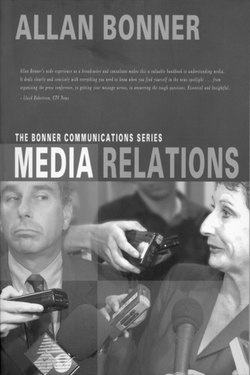Читать книгу The Bonner Business Series â Media Relations - Allan Bonner - Страница 3
Foreword
ОглавлениеMy media relations experience began in the media. I was the recipient of news releases, pitches and complaints on a daily basis for 14 years. I found that many people who called me hadn’t thought past the phrase “I think I have a good story for you” when they wanted me to cover something. They also hadn’t thought past “that’s not news” when they wanted me to kill a story.
I also found that few newsmakers had a clear, powerful message to deliver. Most sounded guilty of something. It was years before I realized that many people are just nervous of the media. That’s when I decided there was room in the marketplace for a course on media relations and media training.
I left the media to join a big city mayor as Executive Assistant. He was always in the news. You may have heard of him — Mel Lastman — one of the longest serving mayors in North America. There’s no secret to his success. He got up every day, bound, determined and even possessed to make news. He also made it his business to understand how radio stations, newspapers and TV stations work. I moved on from Mayor Lastman a few years later, but continue to watch his determination from afar.
Another experience which has shaped this book is conducting media relations and media training courses on five continents for some of the toughest clients in the world. When I make speeches I often ask for a show of hands to tell me who’s been in a newsroom in the previous month. Then I ask who has visited a newsroom in the previous quarter or even in the last six months. I often find Public Affairs practitioners who have rarely been in newsrooms.
My goal here is to share with you what I’ve learned during a quarter of a century of work on both sides of the media divide. Many of the problems people have with the news media stem from a lack of knowledge about its role, its interests and motives and its workings.
This book is designed to be a handy reference for those who feel threatened by the attention of the news media, or those who feel they have a story to tell but are being ignored. It contains detailed, stepbystep advice on how to prepare for media encounters, from an unexpected “ambush” interview to a fullscale news conference and then how to follow through and maintain good media relations.
It actually began as a series of lectures to about 1,000 senior military officers across Canada. They were having a tough time getting their story told around the end of the Cold War and I was hired to give them some tools that would work. Then clients in oil and chemicals asked for tough simulations after the Valdez and Bhopal incidents and those assignments honed my knowledge as well.
Work with a great series of clients from the Government of Hong Kong to the UN in New York and from the World Trade Organization in Geneva to the NAFTA negotiating team in Canada allowed me to test my theories out in real time, real life and under real heat.
The book starts by helping you assess your own news value and leads you through the preparation you must undertake before you go anywhere near a reporter. Both the preparation and your actual encounters will be guided by my SOCKO system for key messages.
As your media needs grow, you will find ever more detailed content available — even down to the trash cans needed (but often forgotten) when setting up a temporary public affairs or media work room. Interspersed throughout are templates you can use to organize and keep track of your media relations.
I’m indebted to many people. Chief among them are my two boys, Michael and Christian, and my wife, Lorna Jackson. They endured my travel schedule for many years and have also heard me rehearse many a speech before delivery and pointed out errors and omissions. Michael has helped with semantics, of which he is a master. Christian added value to some concepts of reputation management. I was trying to show a client that there may be some benefit to a bad reputation and used the Rolling Stones as an example. Christian is an expert on them. Lorna, being a thoughtful interviewer and newscaster herself, has been a great seat mate while watching the news (while I critique it) most nights for 21 years.
Hal Jones, my senior consultant and trainer at The Centre for Training in Risk and Crisis Management, went over early drafts of this book and added structure and consistency. He’s a great trainer, exemplary journalist, but the thing I’m most proud of is that, after working with me on many contentious media relations cases over seven years, we still get along.
I am very pleased to be working with two dedicated and talented people at Sextant Publishing, Ken Champman and Satya Brata Das. They are part of Cambridge Strategies, the public policy research group that is dedicated to clarity and action in law making and administration. They conduct research, write discussion papers, give speeches at major conferences and selectively publish works designed to support an informed discussion of important public issues. I’m glad they consider this volume such a work.
The errors and omissions are mine, but thanks to all who helped.
